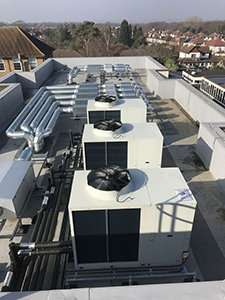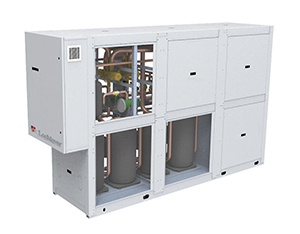Hybrids will be key to cutting carbon

A radical strategy for decarbonising heat in the residential market could also bear fruit in commercial buildings, according to Liam Elmore.
The drive to decarbonise heating is likely to shift up another gear this year as the UK looks for ways of making its aim to achieve a net zero carbon economy by 2050 an achievable goal.
Speaking at the recent CIBSE Build2Perform exhibition and conference, Baroness Brown of Cambridge put a powerful case for using more heat pumps combined with non-renewable technologies to crack the crucial problem of how to improve the carbon footprint of the country’s 29 million existing homes.
As vice chair of the Committee for Climate Change (CCC), the views of this distinguished engineer are increasingly influential in Whitehall’s corridors of power as officials look to shape the new government’s decarbonisation strategy. She is urging officials to make low carbon heating a major priority and to put heat pumps front and centre in the new administration’s plans for achieving the extra emissions reductions needed to meet the 2050 target.
 |
The UK is making good progress on decarbonising its electricity supply, which supports greater use of heat pumps, but will have to significantly expand grid capacity to keep pace with growing demand for electric solutions.
“We have only seen very small progress on reducing emissions from buildings in the past five years,” she told the CIBSE event. “So it is very important that we focus hard on this area if we are going to have any chance of reaching our 2050 net zero goal.”
Her view is that any attempt to switch existing homes completely to heat pumps would be practically impossible. Instead the CCC is advising the government to look at hybrid solutions where the heat pumps are deployed to provide the base load with gas-fired technologies providing the top up heating and hot water at times of highest demand.
She believes this will allow more flexibility with only an additional 40kW of electricity required to power the heat pump in each home and overall gas consumption reduced as the gas-fired heating and/or hot water would only operate intermittently.
Integrated/hybrid systems that combine renewable and gas-fired technologies are an excellent way to meet performance targets at a lower capital cost than a fully renewable option and, as a result, are likely to deliver a faster return on investment for commercial building owners. This means they are more likely to be taken up on a greater scale and, therefore, will deliver more energy and carbon reductions in the long-term.
Hybrids also reduce running costs and extend the operating life of the equipment by only using the gas-fired products in back-up mode. This is another key to reducing carbon. If you have to replace products on a regular basis, you will increase your overall carbon footprint significantly.
Improving energy efficiency in homes to reduce fuel poverty was something of a headline grabber during the recent General Election campaign, but there is also a need to upgrade existing commercial buildings and there is no reason why the same hybrid principle could not be applied there too.
Around 80% of the commercial buildings that will be with us when we arrive at our 2050 destination are already built and, in many cases, it would be financially and practically challenging to retrofit to renewable only or all-electric heating and hot water. The replacement of gas-fired boilers with heat pumps in a care home for example, is likely to require a complete system redesign as existing heat emitters may not be suitable for the low-grade heat produced by heat pumps.
The ability, therefore, to provide a hybrid solution including heat pumps, high efficiency gas-fired boilers and direct gas-fired water heaters can unlock significant cost and carbon savings in commercial retrofit projects despite heating and hot water demand being fundamentally different from homes.
Hot water requirements, in particular, are often subject to heavy demand over short peak periods in leisure centres and hotels, for example. This makes this kind of building ideal for a hybrid approach as direct gas-fired water heaters (DGFWHs) can be used to rapidly respond to peak hot water demands as they operate on the principle of low storage with fast heat recovery rates.
DGFWHs have been providing efficient water heating solutions for commercial buildings in the UK for more than 40 years, and are designed on the basis of low storage, but fast hot water recovery. They can provide up to 10,000 litres of hot water per hour from a single water heater.
 |
Efficient
The different types of DGFWHs provide specifiers and contractors with a range of flexible solutions and almost all of today’s models use condensing technology, so are highly efficient.
DGFWHs are ideal for being paired with heat pumps, which can be used to provide pre-heated water that further improves the energy efficiency of the hot water system. Heat pumps alone may struggle to meet the demands of a commercial building that required high volumes of hot water in short peak periods because they produce low temperature heat.
However, in tandem with a conventional, high efficiency gas-fired technology they can both satisfy the requirements of the building occupants while also meeting regulatory and planning restrictions that will, in most cases, insist on energy efficient operation and some renewable element in the system design.
As well as meeting the carbon reduction targets outlined by Baroness Brown, this approach of combining heat pumps with high capacity heating and hot water systems is also an excellent way of addressing the perennial ‘performance gap’ problem where buildings often fail to meet their intended targets for energy, comfort and healthy living conditions.
Taking the hybrid route is a good way to keep everyone happy – including government policy advisers, environmental campaigners and building users – without the expense and technical headaches caused by trying to switch many existing buildings over to fully renewable solutions.
Liam Elmore is sales director of Lochinvar.







